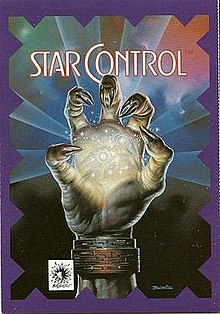| Star Control | |
|---|---|
 Sega Genesis cover art by Boris Vallejo | |
| Developer(s) | Toys for Bob[1] |
| Publisher(s) | Accolade[1] |
| Producer(s) | Pam Levins |
| Designer(s) | Fred Ford Paul Reiche III |
| Programmer(s) | Fred Ford Robert Leyland |
| Artist(s) | Greg Johnson Paul Reiche III Erol Otus |
| Composer(s) | Kyle Freeman Tommy V. Dunbar |
| Platform(s) | Amiga, MS-DOS, Sega Mega Drive/Genesis, Amstrad CPC, Commodore 64, ZX Spectrum |
| Release | July 1990 (Amiga, DOS) 1991 (ports) |
| Genre(s) | Action, strategy |
| Mode(s) | Single player, multiplayer |
Star Control: Famous Battles of the Ur-Quan Conflict, Volume IV is an action-strategy video game developed by Toys for Bob and published by Accolade. It was originally released for MS-DOS and Amiga in 1990, followed by ports for the Sega Genesis and additional platforms in 1991. The story is set during an interstellar war between two space alien factions, with humanity joining the Alliance of Free Stars to defeat the invading Ur-Quan Hierarchy. Players can choose to play as either faction, each with seven different alien starships which are used during the game's combat and strategy sections.
The game was created by designer-artist Paul Reiche III and programmer-engineer Fred Ford. Initially, the concept was based on the space combat seen in Spacewar! (1962), combined with the action-strategy gameplay seen in Archon: The Light and the Dark (1983). The alternate title, StarCon, was a play on words referring to Reiche's prior work on Archon, adapted into a science fiction setting. After developing the core space combat system, Reiche and Ford created an assortment of ships, abilities, and character designs. The project was completed with additional artwork from Greg Johnson and Erol Otus.
Star Control was a critical and commercial success upon its release, leading to two sequels, Star Control II in 1992 (and the free open-source remake The Ur-Quan Masters in 2002), and Star Control 3 in 1996. It has since been ranked among the best games of all time by Polygon and VideoGames & Computer Entertainment, remembered for the replay value of its combat, as well as the colorful worldbuilding that gave rise to its acclaimed sequel. Years after its release, game designers have continued to cite Star Control as an influence on their work, including Mass Effect (2007), and Stellaris (2016).